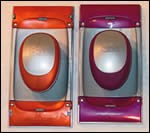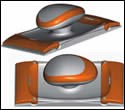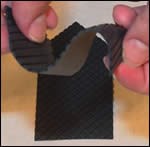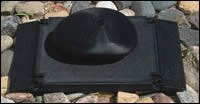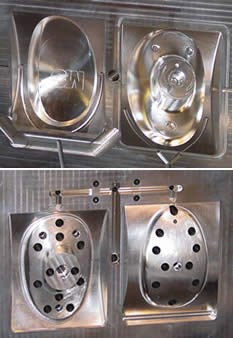Time and Money Saved with RP/RT Strategy
Using a variety of rapid prototyping and rapid tooling techniques, 3M was able to bring a new product to market faster and less expensively.
#3dprinting
A production hand sander that was prototyped in an aluminum tool before production tooling was released. Images courtesy of Vista Technologies.
3M is world-renowned for its innovation. With more than 55,000 products, 30-plus core technologies and leadership in major markets, 3M serves as an example to other manufacturers of efficient, innovative product development. So when Vista Technologies (Vadnais Heights, MN) was able to help 3M bring a new product to market faster and less expensively using a variety of rapid prototyping (RP) and rapid tooling (RT) techniques, they knew they had the beginnings of a great partnership.
Featured Content
3M was developing a new line of ergonomic sanding tools. These tools are part of a large sanding tool and abrasive product development program intended to set new competitive standards. The new products are sold under the Sand-blaster™ brand. Time-to-market was critical. The sanding tool designs had been through the concept phase, illustrations of possible designs had been evalu-ated, 3-D renderings had been reviewed by marketing for style and appeal, and finally the program was approved to move forward. It was time to go—fast.
Initial Prototyping
3M began this phase by creating stereolithography (SLA) patterns with its in-house SLA equipment. Overflow SLA work was sourced to Vista Technologies. The SLA prototypes were used by engineers and industrial designers to check fit and form. The same prototypes were used by 3M packaging engineers to create conceptual mock-ups of product packaging. They also made excellent tools for ergonomic and usability studies.
To mimic the soft under pad of the sanding tool, Vista used PolyJet™ rapid prototyping technology. PolyJet was chosen because it can use either of two soft-durometer (a hardness measurement) materials that can be run to gain similar quality parts as SLA technology. TangoBlack, a material with a score of 61 on the Shore A durometer scale, was the best fit. Within days Vista was able to supply 3M with their simulated soft-durometer under pads for more testing.
At the same time, a gripping/tensioning mechanism for the sanding media was being developed. At this point, the sub-assemblies were merged into a refined set of CAD databases. Additional SLA parts were created to evaluate the new mechanisms. With each new prototype, the team was able to investigate new features in the design. Because these rapid prototype parts could be created cost-effectively in a matter of hours instead of days or even weeks, the team had the ability to study complex forms and details in a manner not possible using traditional machining and fabrication techniques. In some cases multiple iterations were generated in one or two days.
Second-Generation Rapid Prototypes: More Realistic Simulations
In the second generation of the prototypes, 3M needed the hinge function and material properties to be simulated more realistically. After a few design changes were made to the CAD data, Vista Technologies supplied 3M with a Fused Deposition Modeling (FDM) prototype.
The FDM part, made from extruded black ABS, allowed for more robust testing and provided similar specified material properties in weight and strength as the final part would have. This prototype was able to handle a variety of tests that allowed 3M to modify their design before production tooling was released.
Rapid Tooling Takes Over
Once 3M completed its work with prototypes, it was time for rapid tooling. Vista Technologies quickly created aluminum tools. Milled at 42,000 rpm with high-speed milling technology and a proprietary fixture system, these tools were made for quick turns and quick modifications.
The aluminum tools could be modified, polished, textured, welded on, and were capable of shooting 10,000-plus parts. Vista Technologies supplied injection-molded parts within two to three weeks of usable CAD data. By getting specified material parts in hand, 3M could complete their required testing.
The rapid tools supplied by Vista Technologies were for multiple parts that made up the sanding products. The parts were made in family tools—meaning several related parts were made in the same tool. By adding runner shut offs to the tools, 3M could turn on or turn off certain parts of the tool—thereby making only the parts they needed. This kept costs down while minimizing wasted material in extra mold inserts. The molds were made with hand pick-outs and manual slides to capture several undercuts in the part design.
3M chose the rapid tooling approach because it allowed them to quickly evaluate different part features and molding parameters. Tooling changes could be completed and parts resampled for evaluation in just a few days. This was a tremendous advantage to 3M.
From an engineering standpoint, they were able to sample several materials for strength and repetitive testing. They were also able to compare the functionality of various latch mechanisms and to check material flow and gate locations (points where material is injected into the tool).
From a marketing standpoint, along with sampling different materials, they also were able to mold parts in a variety of colors to get important feedback from focus groups. By the time databases were released for production tooling, the mold designs had been optimized and the material and color strategies were in place.
By using rapid tooling, 3M discovered many things in the functional prototypes before cutting production tools. The gating was changed on the production tool, the snap-fit features were redesigned, the handle was modified and ultrasonic energy directors were added for sonic welding of parts in final assembly.
Summary
As rapid prototyping and rapid tooling technologies become more sophisticated, the importance of picking the correct technology for product applications can be critical to gaining a competitive edge. As 3M found, a combination of RP and RT technologies and materials helped them save money, speed development time and establish a foothold in the marketplace.
RELATED CONTENT
-
Hot Runners and Valve Gate Systems: A Moldmaking Team
Valve gates provide several advantages when using hot runners, including better appearance, safety and an overall better product. There are several types of valve gates, and it is important to choose the right one for your project.
-
10 Considerations for Choosing a Robot
Knowing what to look for is essential when comparing and evaluating robots from different manufacturers.
-
Plastic Prototypes Using Silicone Rubber Molds
How-to, step-by-step instructions that take you from making the master pattern to making the mold and casting the plastic parts.





